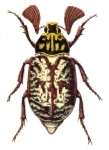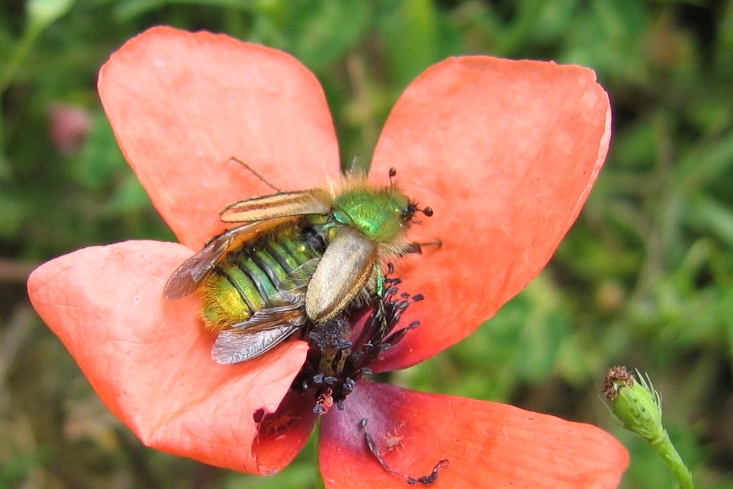|
Description / Habitats / Flora / Vertebrates / Insects / Invertebrates / What's that Bug? Home / Nestos Delta / Bibliography / About this site / Links / Contents / Galleries ____________________________________________________________________________ |
|
__________________________________________________________________________________________________________ THE CHAFERS & DUNG BEETLES etc. (COL., SCARABAEOIDEA) OF THÁSOS
Eulasia pareyssei [(c) L. Chilton] The Scarabaeoidea is a large and diverse group of related Families that are strongly represented in the Mediterranean region. The classification of Families within this group seems to be in almost constant revision but, as adopted here, four have been recorded on Thásos: the Geotrupidae (dor beetles), Glaphyridae (bumble bee scarab beetles), Ochodaeidae (sand-loving scarab beetles) and Scarabaeidae (chafers & dung beetles). Ecologically they occupy a wide range of niches, with species breeding on dung, feeding on plant roots, in dead and dying trees, in birds' nests, etc. On Thásos, the majority of recorded species develop either within the soil or on mammal dung, with the adults of former visiting flowers and the latter mainly ground active. The flower-visitors are the most conspicuous species amongst the Scarabaeoidea on the island and in early summer Cistus bushes can be covered with rose chafers Cetonia aurata and their Protaetia relatives. Composites and umbellifers are especially attractive to the distinctive black and white-spotted adults of Oxythyrea spp. and the noticeably hairy Tropinota spp. Dung-feeders are less obvious, but in the uplands you can occasionally come across the curious adults of Sisyphus schaefferi rolling goat droppings along.
Cetonia aurata [(c) V.J. Monaghan] Tropinota hirta The Scarabaeoidea are one of the better known invertebrate groups on Thásos as Karnozickij (1959) evidently took an interest in them during his collecting in 1943. He recorded a total of thirty-three species, twenty-one of which have not been recorded since. Whilst this may suggest an impoverishment of the scarab fauna on the island, it more probably reflects the attention Karnozickij paid to the dung fauna, as sixteen of those twenty-one species are dung-feeders. In May 1973 M. & T. Cerruti collected insects on Thásos and added two scarab species, Elaphocera denticornis & Omaloplia cerrutii (Sabatinelli 1977, 1979). The latter species was described as new to science from these specimens, with Thásos as the type locality, but it is now also known from north-eastern Greece, Bulgaria and Romania (Rössner 1995). Oxythyrea cinctella, which appears to be as common as O. funesta here, was added to the island list in 1982 by Brian Levey. My own studies have increased the island's scarab fauna by a further twelve species (asterisked in the Checklist below) to 48. These include Ochodaeus integriceps, the first representative of the sand-loving scarabs (Ochadaeidae) on Thásos, the eastern Mediterranean Ataenius horticola, numerous pine chafers Polyphylla fullo at light on Limenas harbour in June 2007, and a single specimen of Tropinota squalida, which appears to be much less frequent than its commoner relative T. hirta. I have also collected four specimens of Omaloplia cerrutii on the island and it is interesting that, so far, no other species in this genus have been recorded here. Whereas Karnozickij (1959) mainly recorded dung-feeders, perhaps at a time when livestock were more abundant on the island, my collecting of scarabs has mainly been as a result of sweep-netting in grasslands for weevils and hence is biased towards flower-visiting chafers. There is no doubt that many more species remain to be discovered, including perhaps the remarkable bumble bee chafers of the genus Pygopleurus. Bollino & Ruzzante (2015) report five species of these attractive and highly distinctive chafers from nearby Lesbos but none have been seen so far on Thásos. This is probably because they emerge in Spring and are generally found in March in this region, much earlier than any of the visits I have been able to make to the island. There do not appear to be any comparable checklists of the scarab fauna from other Aegean islands to put Thásos into context. The Italian Scarabaeoidea fauna contains at least 367 species (Ruffo & Stoch, 2006) and in Bulgaria Petrova et al. (2016) estimate 300 species occur, whilst Guéorguiev et al. (2011) report on 138 species recorded from the Bulgarian part of the Western Rhodopes alone (immediately north of Thásos). In neighbouring Turkey, Carpaneto et al. (2000) list an astonishing 625 species, but in an analysis of zoogeography in Greece he expected the Greek dung beetle fauna to consist of no more than 150 species (Carpaneto 1985) in the Scarabaeidae, Geotrupidae and Aphodiidae (based on a total of 118 known species excluding Psammodiinae, Aegialinae and Lethrinae). The most comprehensive text on European scarab beetles is Baraud's (1992) volume in Faune de France, which is a little outdated now but still extremely useful. For the Greek fauna, the excellent online key provided by Colleoteri Scarabeoidei d'Italia can be very helpful to identify specimens to genus level (and often to species). Huchet (2016) provides a key to the Greek species of Ochodaeidae and Sabatinelli (1981) illustrates the characteristics of Mediterranean Oxythyrea.
Oxythyrea funesta [(c) L. Chilton] CHECKLIST
Geotrupidae Typhaeus typhoeus (Linnaeus, 1758)
Glaphyridae Ochodaeidae Ochodaeus integriceps Semenov, 1891 *
Scarabaeidae
Pleurophorus pannonicus
Petrovitz, 1961
*
REFERENCES
Baraud J. 1992. Faune des Coléoptères Scarabaeidae d'Europe. Volume 78. Société Linnéene de Lyon. Bollino, M. & Ruzzante, G. 2015. Corological notes on some species of Pygopleurus (Coleoptera: Glaphyridae) from the Greek island of Lesbos. Mun. Ent. Zool., 10: 69-74. Carpaneto, G.M. 1985. Distribution patterns and zoogeographical analysis of dung beetles in Greece (Coleoptera, Scarabaeoidea). Biologia Gallo-Hellenica, 10: 229-244. Carpaneto, G.M., Piattella, E. & Pittino, R. 2000. The scarab beetles of Turkey: an updated checklist and chorotype analysis (Coleoptera, Scarabaeoidea). Biogeographia, 21: 217-240. Guéorguiev, B., Lobo, J. & Chehlarov, E. 2011. The Scarabaeoid Beetles (Insecta: Coleoptera: Scarabaeoidea) in the Bulgarian Section of the Western Rhodopes. In: Beron P. (ed). Biodiversity of Bulgaria. 4. Biodiversity of Western Rhodopes (Bulgaria and Greece). National Museum Natural History, Sofia: 237-265. Huchet J.-B. 2016. Un nouveau genre et une nouvelle espèce d'Ochodaeidae pour la faune d'Europe (Coleoptera : Scarabaeoidea). Coléoptères, 22: 38-53. Karnozickij, N. 1959. Materialien zur Koleopteren-Fauna der Agäischen Küste und Insel Thasos. Izv. zool. Inst. Sof., 8: 237-253. Petrova, Y., Chehlarov, E. & Gradinarov, D. 2016. Scarabaeoid beetles (Coleoptera: Scarabaeoidea) from Vrachanska Planina Mountains and Vrachanski Balkan Nature Park. In: Bechev, D. & Georgiev, D. (eds.). Faunistic diversity of Vrachanski Balkan Nature Park. ZooNotes, Supplement 3, Plovdiv University Press. Rössner, E. 1995. Neue Kenntnisse zur Verbreitung von Omaloplia cerrutii Sabatinelli, 1977. Entomologische Nachrichten und Berichte, 39:133-136 Ruffo, S. & Stoch, F. (Eds). 2006. Checklist and Distribution of the Italian Fauna. 10,000 terrestrial and inland water species. Memorie del Museo Civico di Storia Naturale di Verona, 2° serie, Sez. Scienze della Vita. 17: 1-303. Sabatinelli, G. 1977. Tre nuovo Sericini di Grecia e Turchia (Coleoptera Scarabaeidae, Melolonthinae). Fragm. Ent., XII: 107-118. Sabatinelli, G. 1979. Nuovi reperti di Scarabaeoidae floricoli nelle isole dell'Egeo (Coleoptera). Bollettino Associazione romana di Entomologia, 34: 63-66. Sabatinelli, G. 1981. Le Oxythyrea Muls. del Mediterraneo: studi morfologici sistematici (Coleoptera, Scarabaeoidae). Fragmenta Entomologica, 16: 45-60.
|


















%201.jpg)